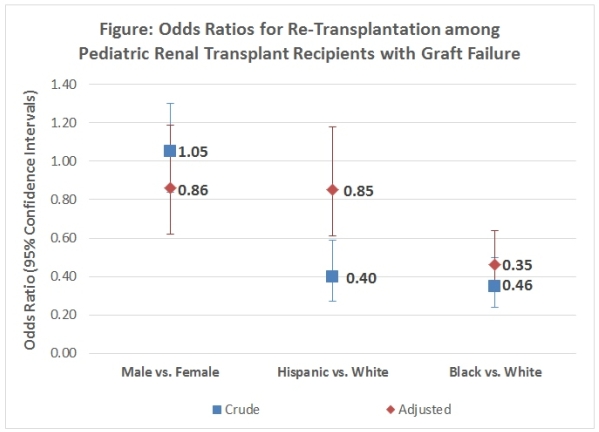Disparities in Re-Transplantation among Pediatric Renal Transplant Recipients with Graft Failure
1Emory University School of Medicine, Atlanta, GA
2Pediatric Nephrology, Children's Healthcare of Atlanta, Atlanta, GA.
Meeting: 2018 American Transplant Congress
Abstract number: B230
Keywords: Kidney, Pediatric, Retransplantation, Risk factors
Session Information
Session Name: Poster Session B: Kidney: Pediatrics
Session Type: Poster Session
Date: Sunday, June 3, 2018
Session Time: 6:00pm-7:00pm
 Presentation Time: 6:00pm-7:00pm
Presentation Time: 6:00pm-7:00pm
Location: Hall 4EF
Background: While gender and racial disparities in access to transplantation have been reported among pediatric patients, few studies have investigated if these disparities exist in re-transplantation.
Methods: We examined factors associated with re-transplantation after graft failure among patients diagnosed with end-stage renal disease (ESRD) from 2005 to 2016, who were <21 years at diagnosis. Re-transplantation was defined as the patient's second transplant. Male vs. female and Black and Hispanic vs. White odds ratios for re-transplantation were calculated using logistic regression.
Results: Among 14,115 ESRD pediatric patients, 9,212 received an initial transplant; 1,596 of transplant patients had graft failure (15% of males vs. 20% of females, p<.0001; 16% of White, 16% of Hispanic, and 25% of Black patients, p<.0001). Among patients with graft failure, 435 (27%) were re-transplanted. Re-transplanted patients were 48% female, 58% White, 22% Hispanic, 17% Black, with a mean age of 15 (IQR: 9-17) at ESRD diagnosis; 67% of re-transplants were from a deceased donor. Median time from graft failure to re-transplantation was 526 days (IQR: 179-1,153). Gender disparities in re-transplantation were not observed among pediatric patients with graft failure in unadjusted (male vs. female OR: 1.05 (95% CI: 0.84-1.30)) or adjusted (male vs. female OR: 0.86 (0.62-1.19)) analyses. Racial disparities were observed in unadjusted analyses, with Hispanic (OR: 0.40 (0.27-0.59)) and Black (OR: 0.35 (0.24-0.50)) patients being far less likely to be re-transplanted compared to White patients. After adjusting for age, sex, ESRD etiology, insurance, poverty, and OPO region, racial disparities were no longer significant for Hispanic vs. White patients (OR: 0.85 (0.61-1.18)), but persisted for Black vs. White patients (OR: 0.46 (0.33-0.64)). Conclusion: Gender disparities were not observed in re-transplantation among pediatric renal patients with graft failure, yet racial disparities persist in this population. Future studies should determine factors contributing to these racial disparities.
Conclusion: Gender disparities were not observed in re-transplantation among pediatric renal patients with graft failure, yet racial disparities persist in this population. Future studies should determine factors contributing to these racial disparities.
CITATION INFORMATION: Basu M., Patzer R., George R. Disparities in Re-Transplantation among Pediatric Renal Transplant Recipients with Graft Failure Am J Transplant. 2017;17 (suppl 3).
To cite this abstract in AMA style:
Basu M, Patzer R, George R. Disparities in Re-Transplantation among Pediatric Renal Transplant Recipients with Graft Failure [abstract]. https://atcmeetingabstracts.com/abstract/disparities-in-re-transplantation-among-pediatric-renal-transplant-recipients-with-graft-failure/. Accessed July 18, 2025.« Back to 2018 American Transplant Congress
